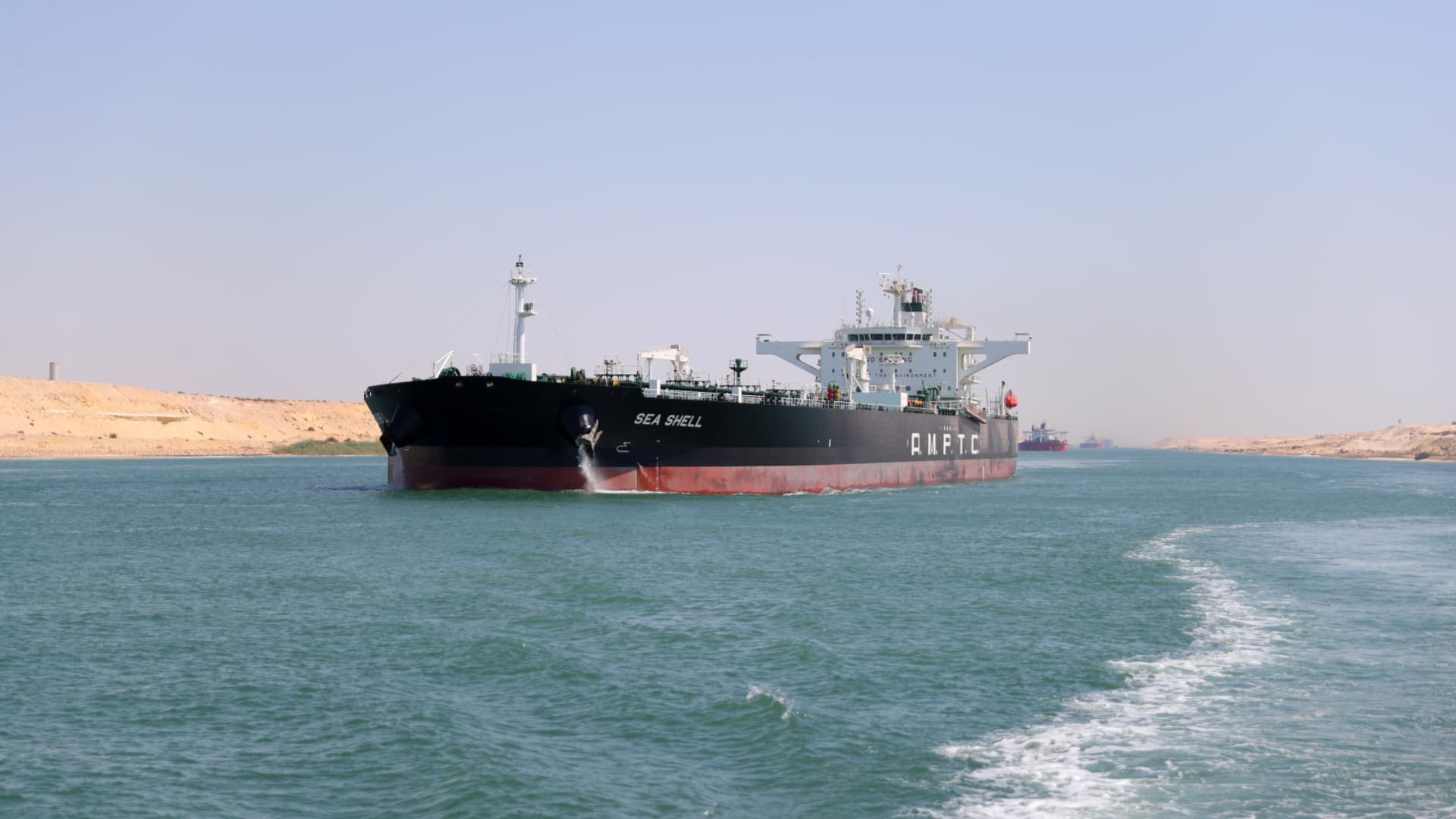Tihama, a Maltese Flag container ship of shipping line Hapag-Lloyd, at a European dock on August 13, 2022.
Thierry Monasse | Getty Images News | Getty Images
BP has become the latest firm to pause travel through the Suez Canal following a series of attacks on vessels by Houthi militants from Yemen.
In a statement Monday, BP said the safety of its workers was its priority.
“In light of the deteriorating security situation for shipping in the Red Sea, bp has decided to temporarily pause all transits through the Red Sea,” it said. “We will keep this precautionary pause under ongoing review, subject to circumstances as they evolve in the region.”
Shipping giants MSC, Hapag-Lloyd, CMA CGM and Maersk have also all announced suspensions of travel through the Red Sea due to the drone threat, meaning no access to the key link between Europe and Asia between the Middle East and North Africa.
Analysts say the move could cause a major shock to global supply chains.
“You are going to see some fairly seismic activity in terms of the implications for supply chains” if all current and expected reroutings are sustained, Richard Meade, editor in chief at shipping journal Lloyd’s List, told CNBC Monday before BP announced its suspension.
The shipping industry has been unable to avoid getting sucked into geopolitical tensions around the Israel-Hamas war. Iran-backed Houthis have vowed to continue strikes against Israel and ships heading toward Israel until “aggression” in the Gaza Strip stops. The Suez Canal runs through Egypt, which borders Israel to the south.
The latest incident was reported Monday, with U.S. officials telling Reuters the M/V Swan Atlantic — a chemical and oil products tanker — was attacked in the southern Red Sea by multiple projectiles launched from Houthi-controlled territory.
Naval escorts
In response to the attacks, the U.S. is expected to announce an expanded maritime protection force in collaboration with Arab states.
For Meade, “a lot depends” now on naval protections.
“There is a huge amount of naval presence in the region, and we’re hearing talk of naval escorts. But this is not the same as when we saw naval escorts being deployed to try and resolve the piracy situation in Somalia 10 years ago, it’s much bigger,” he told CNBC’s “Street Signs Europe.”
Also, the threat of aerial attacks requires a “sustained naval presence with fairly sophisticated anti-drone equipment on board,” Meade said, and it is unclear whether the proposals will be enough to see companies reverse course and how soon that might be.
“It’s not just a question of naval escorts. We’re going to have to wait and see what happens in terms of whether there are strikes, I think, in terms of the Houthi threat being eliminated,” he said.
Monitoring threat
In a statement posted online Sunday, managing director of the Suez Canal Authority Ossama Rabiee said traffic through the canal was moving “normally.”
“We are watching closely the repercussions of the ongoing tensions in the Red Sea on the navigation through the Suez Canal,” Rabiee said.
The statement added that since Nov. 19, just 55 vessels had rerouted through the Cape of Good Hope — the longer journey around the south of Africa — while 2,128 vessels had passed through the Suez Canal.
Simon Heaney, senior manager for container research at Drewry, highlighted the major uncertainty facing the shipping industry at present, particularly surrounding how long the current situation will last.
Compounding the pressure on global trade routes is the fact that access to the Panama Canal, another key route, is severely restricted due to low water levels, he noted.
However, he told CNBC by phone that he did not expect as much disruption to supply chains, or as sharp an impact on freight rates, as was seen during the pandemic.
Huge congestion at ports constrained supply capacity throughout 2020 and into 2021, pushing freight rates to unprecedented levels — and seeing shipping firms report record profits in the process.
But since then, many new ships have been ordered and the situation has recently been one of oversupply.
Current events “change the fundamentals” in the market, Heaney said. “We’ve been in a downcycle, with the market oversaturated with an abundance of ship capacity — so this will come to the rescue for carriers which have a surplus,” Heaney said.
“Too many ships is a good thing because it can cater for these disruptive events.”
For the owners of cargo, however, the current disruption could mean either longer lead times for goods to arrive, or having to pay more to justify carriers traveling faster.
“In shipping there is always an alternative pathway, it will just take longer and time equals cost. However, carriers may opt to travel faster because they will save millions on Suez transit fees,” Heaney said.
“Liners will recalibrate and the worse will be in the initial phase while they make this adjustment. Freight rates are going to be on the up again, but I don’t think they will go up as dramatically as before.”
